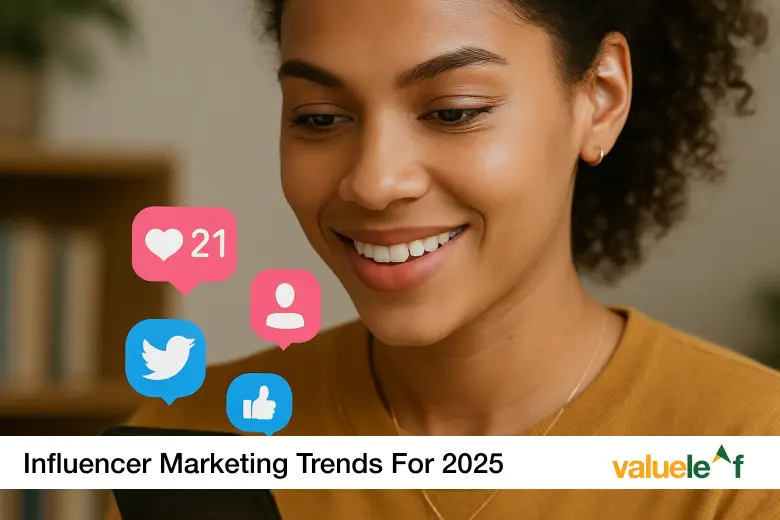Introduction
Influencer marketing is evolving faster than ever, reshaping how brands connect with consumers. As we enter 2025, the influencer marketing industry shows no signs of slowing down, with a projected global market size of $32.55 billion by 2025.From the explosion of short-form videos to AI-driven campaign strategies and a rising demand for authenticity, brands must adapt to the changing landscape to stay competitive.
Read the blog to know the major influencer marketing trends for 2024 and how brands can prepare for the future of influencer marketing.
Influencer Marketing Still Dominates in 2025
|
Top Influencer Marketing Trends for 2025
Influencer marketing in 2025 is being shaped by authenticity, technology, platform diversification and long-term brand partnerships. Brands must adapt to these emerging trends to stay relevant, build trust, and drive stronger campaign outcome.
- Micro- and Nano-Influencers Surge: Nano-influencers now form 75.9% of Instagram’s influencer base. Brands are choosing smaller, niche creators for higher engagement and stronger audience trust.
- Authenticity Over Perfection: Consumers prefer raw, relatable content over polished ads.
- AI Transforming Influencer Campaigns: AI now powers influencer discovery, campaign management, and ROI tracking.66.4% of marketers report better results through AI integration.
- Rise of Multi-Platform Strategies: Post the TikTok US ban, brands are expanding across YouTube Shorts, Reels, and LinkedIn.Multi-platform presence reduces risk and boosts audience reach.
- 5. Shift to Long-Term Collaborations:Long-term relationships build loyalty, trust, and consistent brand advocacy. 47% of brands now focus on sustained influencer partnerships.
Types of Influencer Marketing in 2025
In 2025, influencer marketing has diversified into multiple innovative formats, driven by technology, authenticity, and platform-specific strategies. Brands are adopting a mix of traditional and emerging models to maximize reach, trust and campaign impact.
1. Sponsored Content: Brands pay influencers to create and share content featuring their products or services.
Focus in 2025: More authentic storytelling rather than scripted promotional posts.
2. Affiliate Marketing Collaborations: Influencers promote products using a unique affiliate link and earn a commission for every sale they drive.
Focus in 2025: Performance-driven partnerships with clear ROI tracking.
3. Product Seeding (Gifting): Brands send free products to influencers without any paid obligation, hoping they will genuinely review and recommend them.
Focus in 2025: Micro- and nano-influencers are increasingly targeted for authentic, organic endorsements.
4. Co-Creation and Brand Ambassadorships: Brands and influencers collaborate to create new products, limited editions, or long-term ambassador roles.
Focus in 2025: Building long-term brand-influencer relationships that drive loyalty.
5. Giveaways and Contests: Influencers host giveaways sponsored by brands to boost product awareness, engagement, and follower growth.
Focus in 2025: Interactive and community-driven campaigns that promote viral participation.
6. Live Streaming Campaigns: Influencers engage audiences in real time through live streams, showcasing products, answering questions, or hosting launches.
Focus in 2025: Live commerce and instant shopping integrations during influencer streams.
7. Podcast Sponsorships and Guest Appearances: Brands sponsor podcast episodes or have influencers appear as guests to tap into loyal, niche audio audiences.
Focus in 2025: Podcasts remain a trusted format for in-depth brand storytelling.
8. Platform-Specific Content Partnerships: Brands collaborate with influencers to create platform-tailored content — Reels for Instagram, Shorts for YouTube, Carousels for LinkedIn.
Focus in 2025: Custom content formats optimized for platform-specific engagement.
9. Employee and Internal Influencer Programs: Brands turn their employees, customers, or real users into micro-influencers to share brand stories authentically.
Focus in 2025: Trust-based marketing leveraging internal advocates.
10. AI-Generated Influencer Collaborations: Virtual influencers and AI-generated creators partner with brands for futuristic, scalable marketing campaigns.
Focus in 2025: Growth in virtual influencer partnerships, especially in tech, fashion, and gaming industries.
How Brands Can Adapt Their Influencer Strategy in 2025
As influencer marketing evolves in 2025, brands must rethink their strategies by focusing on authenticity, automation, platform diversification, and meaningful engagement to drive stronger results.
1. Prioritize Authentic Storytelling: Consumers now value genuine, relatable content over scripted, polished advertisements.Brands should give influencers creative freedom to share real experiences, building deeper trust and emotional connections.
2. Leverage AI for Smarter Campaigns
AI-driven platforms streamline influencer discovery, content recommendations, and performance analysis. Integrating AI helps brands optimize targeting, reduce manual effort and maximize campaign ROI.
3. Diversify Across Emerging Platforms
Instead of relying solely on Instagram or TikTok, brands should expand across YouTube Shorts, LinkedIn Creators, Snapchat Spotlight, and niche networks. Multi-platform strategies ensure wider audience reach and protect campaigns from sudden platform risks.
4. Focus on Deeper Engagement Metrics
Brands must track saves, shares, comments, watch time, and brand sentiment to measure real influence and optimize future campaigns.
Emerging Challenges in Influencer Marketing (2025)
While influencer marketing continues to grow in 2025, brands face new challenges around transparency, authenticity, and cost control, making it essential to adapt quickly and strategically.
- Tighter Ad Transparency Laws: Mandatory disclosure regulations are now strictly enforced across most countries, requiring influencers to clearly label paid collaborations.
Fact: According to the Influencer Benchmark Report 2025, 74% of consumers trust creators more when ads are transparently disclosed.
- Managing Fake Influencers: Brands are increasingly using AI-driven tools to detect fake followers, bot engagement, and inauthentic influencer profiles to safeguard budgets and campaign credibility.
Fact: A 2025 survey reveals that 22% of influencers still engage in follower inflation practices, risking brand reputation.
- Budget Efficiency: With rising influencer fees, brands must optimize budgets by focusing on performance-linked payments and tiered influencer partnerships to ensure measurable ROI.
Fact: Influencer marketing costs have risen by 18% in 2025, making cost control strategies critical for brands.
Conclusion
The future of influencer marketing in 2025 is smarter, more authentic and tech-driven.
With live streaming becoming the top content format (favoured by 52.4% of marketers) and 73% of marketers expecting influencer marketing processes to be largely automated, brands must innovate to stay relevant.
Success lies in building long-term relationships, leveraging AI smartly, and embracing authenticity at every step.
FAQs: Influencer Marketing Trends for 2025
1. What is influencer marketing expected to be worth by 2025?
The global influencer marketing industry is projected to reach $32.55 billion by the end of 2025, reflecting its rapid growth and increased brand investments.
2. Why are brands shifting to micro- and nano-influencers?
Micro- and nano-influencers offer higher engagement rates, authenticity, and niche audience targeting, making them more effective than celebrity influencers for building trust.
3. How important is AI in influencer marketing now?
AI tools have become critical for influencer discovery, campaign optimization, fraud detection, and ROI tracking, with 66.4% of marketers reporting better outcomes through AI integration.
4. What is the impact of TikTok’s US ban on influencer marketing?
Due to TikTok’s marketing uncertainty, brands are increasingly diversifying across platforms like YouTube Shorts, Instagram Reels, and LinkedIn Creators to maintain stable audience reach.
5. Why is authenticity more important than polished content?
Consumers now prefer real, relatable experiences over scripted advertising. Authentic influencer content drives deeper engagement and stronger emotional bonds with audiences.
6. What new types of influencer marketing are growing in 2025?
Newer formats like live streaming campaigns, AI-generated influencer collaborations, podcast sponsorships, and employee advocacy programs are becoming popular in 2025.
7. How are brands ensuring ad transparency?
Brands are strictly enforcing mandatory disclosure regulations, as 74% of consumers trust influencers more when partnerships are openly disclosed.
8. What are the main risks in influencer marketing today?
The biggest risks include fake influencers, rising campaign costs, and platform dependency. Brands are combating these with AI verification tools and multi-platform diversification strategies.
9. How can brands measure influencer marketing success better?
Beyond likes, brands should track saves, shares, comments, watch time, click-throughs, and brand sentiment to get a real measure of campaign effectiveness.
10. Why are long-term influencer partnerships critical in 2025?
47% of brands now focus on sustained collaborations with influencers, which help build trust, brand loyalty, and consistent audience engagement over time.




